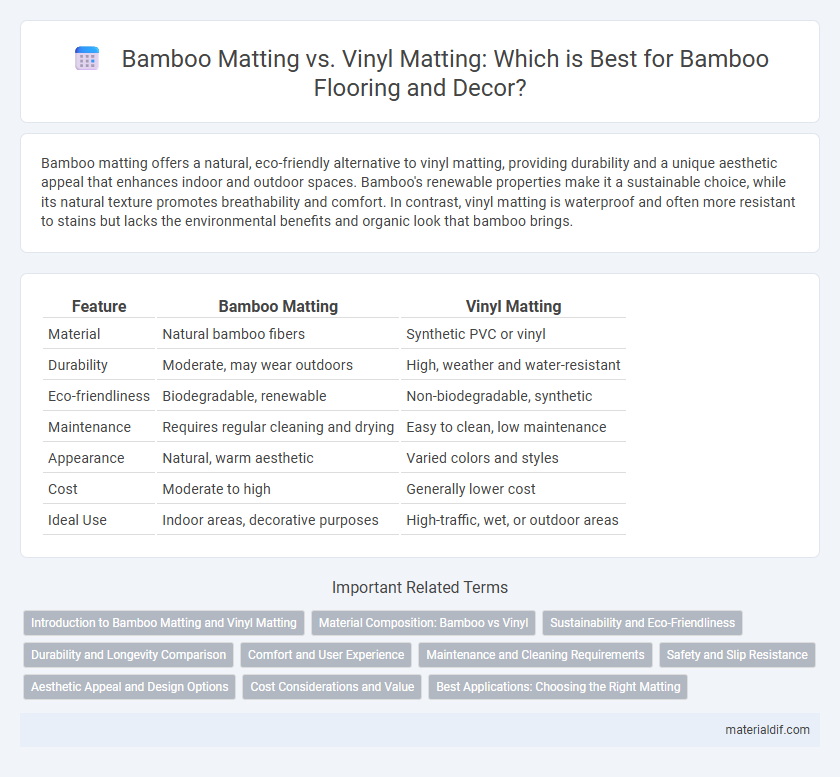Bamboo matting offers a natural, eco-friendly alternative to vinyl matting, providing durability and a unique aesthetic appeal that enhances indoor and outdoor spaces. Bamboo's renewable properties make it a sustainable choice, while its natural texture promotes breathability and comfort. In contrast, vinyl matting is waterproof and often more resistant to stains but lacks the environmental benefits and organic look that bamboo brings.
Table of Comparison
| Feature | Bamboo Matting | Vinyl Matting |
|---|---|---|
| Material | Natural bamboo fibers | Synthetic PVC or vinyl |
| Durability | Moderate, may wear outdoors | High, weather and water-resistant |
| Eco-friendliness | Biodegradable, renewable | Non-biodegradable, synthetic |
| Maintenance | Requires regular cleaning and drying | Easy to clean, low maintenance |
| Appearance | Natural, warm aesthetic | Varied colors and styles |
| Cost | Moderate to high | Generally lower cost |
| Ideal Use | Indoor areas, decorative purposes | High-traffic, wet, or outdoor areas |
Introduction to Bamboo Matting and Vinyl Matting
Bamboo matting is a natural, eco-friendly product crafted from bamboo strips, offering durability, breathability, and a sustainable alternative for flooring and wall coverings. Vinyl matting, made from synthetic polymers, provides water resistance, easy maintenance, and a wide range of colors and patterns suited for high-traffic or moisture-prone areas. Both materials serve distinct functional and aesthetic purposes, with bamboo emphasizing environmental benefits and vinyl focusing on practicality and customization.
Material Composition: Bamboo vs Vinyl
Bamboo matting is crafted from natural bamboo fibers, offering a sustainable, eco-friendly option with strong durability and breathability. Vinyl matting consists of synthetic polyvinyl chloride (PVC), providing water resistance and easy maintenance but lacking the biodegradability of bamboo. The natural cellulose structure of bamboo enhances moisture absorption and temperature regulation, whereas vinyl's plastic composition contributes to its resilience against staining and wear.
Sustainability and Eco-Friendliness
Bamboo matting offers superior sustainability compared to vinyl matting due to its rapid renewability, as bamboo can grow up to 3 feet per day and requires minimal pesticides or fertilizers. Unlike vinyl, which is derived from non-renewable petroleum and contributes to toxic waste and microplastic pollution, bamboo is biodegradable and has a much lower carbon footprint. Choosing bamboo matting supports eco-friendly flooring solutions that promote responsible resource use and reduce environmental impact.
Durability and Longevity Comparison
Bamboo matting offers superior durability due to its natural strength and resistance to wear, making it ideal for high-traffic areas. Unlike vinyl matting, which can crack or peel over time, bamboo maintains its structural integrity and appearance with minimal maintenance. The natural fibers in bamboo provide longevity that outperforms synthetic materials, ensuring a sustainable and long-lasting flooring solution.
Comfort and User Experience
Bamboo matting offers superior breathability and natural cushioning, enhancing comfort by preventing heat buildup and moisture retention compared to vinyl matting. Users often prefer bamboo for its eco-friendly properties and tactile warmth, contributing to a more pleasant and natural sensory experience. Vinyl matting tends to feel denser and less forgiving underfoot, which can result in lower overall comfort during prolonged use.
Maintenance and Cleaning Requirements
Bamboo matting requires regular dusting and occasional wiping with a damp cloth to prevent dirt buildup and maintain its natural appearance, while avoiding excessive moisture to prevent warping or mold growth. Vinyl matting is more resistant to stains and water, allowing for easy cleaning with soap and water or disinfectant without the risk of damage. Both materials demand different maintenance approaches, with bamboo needing gentle care to preserve its organic texture and vinyl offering low-maintenance durability suitable for high-traffic areas.
Safety and Slip Resistance
Bamboo matting offers superior natural slip resistance due to its textured surface and moisture-wicking properties, making it safer in wet environments compared to vinyl matting. Vinyl matting can become slippery when wet, increasing the risk of slips and falls, whereas bamboo's fibrous structure provides enhanced grip. Furthermore, bamboo is non-toxic and eco-friendly, contributing to a safer indoor air quality and reducing chemical exposure compared to synthetic vinyl options.
Aesthetic Appeal and Design Options
Bamboo matting offers a natural, eco-friendly aesthetic with warm, organic tones that complement minimalist and tropical interior designs, while vinyl matting provides a wider range of colors, patterns, and textures suitable for modern or high-traffic areas. Bamboo's unique grain and texture create a handcrafted look that enhances rustic and zen-inspired spaces, whereas vinyl can mimic various materials, including wood and stone, delivering versatile design options at a lower cost. Both materials allow customization, but bamboo emphasizes sustainability and natural beauty, making it ideal for those seeking authentic, earthy decor.
Cost Considerations and Value
Bamboo matting offers a sustainable and cost-effective option with a lower initial investment compared to vinyl matting, which generally has higher upfront costs due to synthetic materials. Bamboo provides long-term value through its natural durability and biodegradability, reducing replacement frequency and environmental impact, while vinyl offers resistance to moisture but may require more frequent replacement due to wear and environmental degradation. Cost considerations favor bamboo for eco-conscious budgets seeking durable flooring solutions, whereas vinyl suits spaces prioritizing water resistance and low maintenance despite higher overall expenses.
Best Applications: Choosing the Right Matting
Bamboo matting offers natural breathability and eco-friendly durability, making it ideal for outdoor patios, garden paths, and eco-conscious interior designs where sustainability and texture are priorities. Vinyl matting provides superior water resistance and ease of cleaning, suited for high-traffic commercial spaces, entryways, and areas prone to moisture such as kitchens and bathrooms. Selecting the right matting depends on balancing environmental impact, maintenance requirements, and the specific functional demands of the installation site.
Bamboo Matting vs Vinyl Matting Infographic

 materialdif.com
materialdif.com